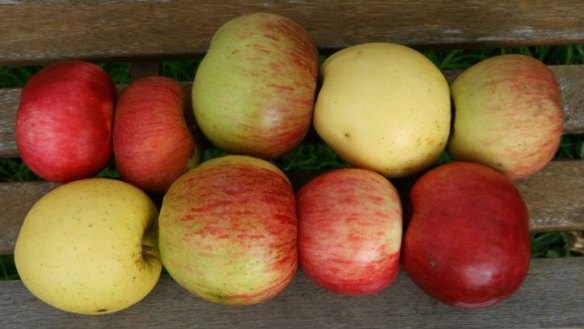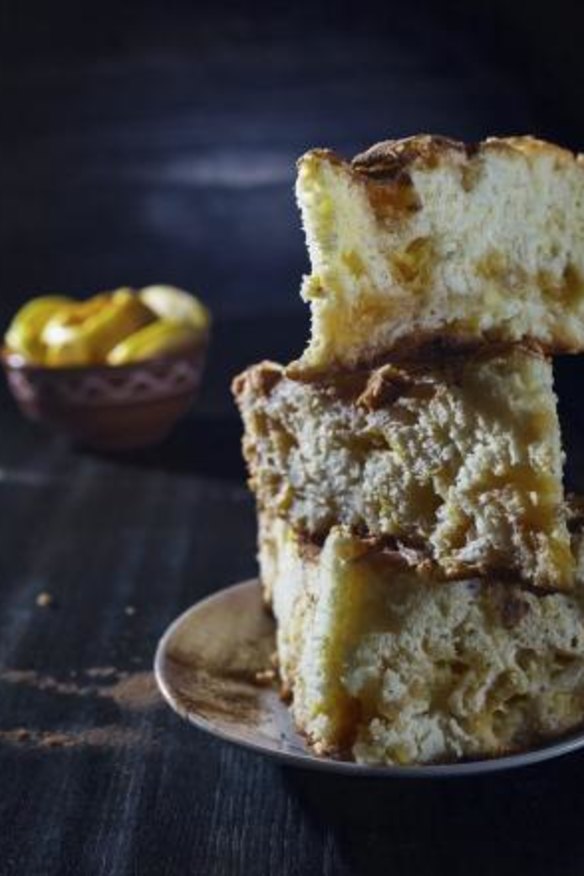Owen Pidgeon: Apples of distinction for the perfect Queen Charlotte pie

As we move into the second half of the apple harvest period, you will find there are many apples that have special qualities and could be rightly described as apple of distinction. Home gardeners and boutique orchards know that there are many excellent varieties that will not be ripe until late April and into the month of May.
And when you come to the cold winter months, a good baking apple is just the thing. For this you need an apple that is neither too sweet or too tart. You will also need to consider whether you want the apple to hold its shape and not break down. Or would you prefer an apple that fluffs up when cooked.
There are a special group of apples that are highly rated for different uses and are naturally large in size. These naturally large apples are often given the status of "exhibition" apples. Let me take you on a journey around the globe, to see and taste some wonderful exhibition apples that we are growing locally at Hall but which have arrived from many lands. Most weigh in between 250-400 grams each but a couple of large Mutzu and Bramley have exceeded 450 grams.

Bonza is the first and only local large apple. It could be considered the only Canberra region apple as it originated in Batlow in 1950, with Jonathan as one of its parents. It is very large in size, distinctively round and with a bright red appearance. It is a crisp and juicy apple, being both excellent for eating fresh and for making apple sauce. Its ability not to brown makes it a good apple to use in salads and to produce dried apple. It is a very dependable cropper and with its natural resistance to apple scab problems it is an excellent variety for organic growers.
Blenheim Orange is a large and beautiful looking apple that has a fine orange and light red blushed appearance. It is a little striped and somewhat russeted. This very famous apple was raised at Blenheim Palace, Woodstock, near Oxford in 1740 and scions were exported to North America in 1820. It is crisp and briskly sweet to eat and will keep for a moderate time. This is a particularly good apple to serve with cheese platters. In addition, it has been traditionally used when baking apple charlotte as it cooks to a stiff puree but tends to keep its shape.
Bramley is the most famous cooking apple from England. It has a tangy lemon flavour and has a high vitamin C content. It will cook up very fluffily and is sought out by many English cooks for pie and tart making.
The Bramley's Seedling apple was raised in 1809 by Mary Anne Brailsford in Southwell, Nottingham. Like the Granny Smith apple this lady had planted just two pips in the ground, with one of them growing into a tree with very impressive apples.
It took nearly 40 years for the Bramley apple to become a recognised apple of distinction and it was a local butcher, of all people, who secured its progeny. In 1857, Mr Matthew Bramley had acquired the rights and with a local nurseryman they took cuttings and began to propagate this variety. It was first produced commercially in 1890.
New Gold is a delightful pure golden "sport" of the original golden delicious. It arose in an orchard in northern France in the late 20th century and was introduced into Australia some 20 years ago, under licensing arrangements. It is medium to large in size. It is a crisp, sweet and rich tasting apple and it keeps better than the traditional golden delicious. When cooked, the slices will keep their shape.
Belle de Boskoop from the Netherlands is one of the reinette family of apples. Its technical name is Golden Reinette. It was discovered in 1856 in a field at Boskoop, and is considered to be a bud sport of the Reinette de Montfort apple. It is a very firm and brisk apple to eat fresh, though it is quite juicy. It is a wonderful aromatic cooking apple, with its slices keeping their shape if not overcooked. It can go on to produce a wonderful, thick golden yellow puree. It is a good keeping apple.
Mutzu is a large sweet tasting exhibition apple, which was raised in 1930 at the Aomori Apple Research Station as a cross between the Golden Delicious and the Indo. It is a good keeper apple.
In Japan, families tend to share just one large Mutzu at mealtimes. It has a rich honeyed flavour and is crisp and juicy. It is good to use in salads and great for cooking in apple pies. When cooked, it retains its sweet tasting character and tends to keep its shape
Twenty Ounce is another large exhibition apple which came from the USA. It first appeared in Connecticut in 1844. The size and weight provided the name to this apple (20 ounces is 566 grams). Our largest one this summer has weighed in at 420 grams. The skin colour has streaks of pale red over a green backdrop. It is a fine tasting apple to eat and to cook with. The slices of this apple will retain their shape and they have a distinctive light lemon colour when cooked.
Rome Beauty is a fine, large late season apple which looks beautiful and stores well over the winter months. It arose as a seedling on the farm of Joel Gillett in the township of Rome, Ohio back in 1816. After 30 years, it was recognised as an excellent commercial variety and cuttings were taken to Europe and Australia. It is highly regarded to use for baked apples and it makes a lovely apple juice.
Ida Red is a large exhibition apple from the USA. The Idaho Agriculture Experiment Station successfully crossed the Wagener and Jonathan apples in the 1930s to produce this fine red apple with very white flesh. It is firm, crisp and juicy when eaten straight off the tree. It is a good all-round apple and makes an especially fine apple sauce.
Take the opportunity to try out some of these international varieties and maybe consider planting one or two trees over winter, to have your very own supply.
Apple Charlotte
This ancient English pudding recipe uses delicious cooking apples that fluff up and produce a smooth puree. It dates back to the 15th century and was named after Queen Charlotte, the wife of King George III.
1kg cooking apples
1 lemon, juice and zest
3 tbs brown sugar
½ tsp ground cinnamon
pinch of nutmeg, freshly grated
50g butter
12-15 slices wholemeal bread
Optional: add 1 cup of blackberries or loganberries
Peel, core and slice the apples. Melt the butter in a heavy based saucepan and add the sliced apple, lemon juice and zest, sugar, cinnamon and nutmeg. Bring to a simmer and stir frequently. Cook until the apples have broken down and become soft. Turn up the heat until any excess liquid has evaporated (keep stirring continuously to avoid burning on the bottom) and you have produced a thick puree.
Trim off the crusts from the bread and cut six of the slices into triangles and the other slices into halves. Brush the bread sections with warmed butter. Lightly grease a 15cm round cake tin and line the base of the pan with the triangles of bread. Line the sides with halves of bread, overlapping a little to ensure there are no gaps. Let the side bread sections protrude slightly above the rim of the cake tin.
Spoon the apple puree into the tin and then cover with more triangles of bread. Fold over the tops of the side lining bread to seal off the charlotte. Bake in the oven for 30 minutes, until the top is golden brown.
After removing from the oven, allow to sit for one to two minutes then carefully invert and place onto a warmed plate, ready to serve with fresh cream or custard.
This week in the garden
▪ Sow out broad beans and field peas, whererever you have space.
▪ Sow mesclun salad mix and provide some protection with a plastic cover lifted above the ground with wire hoops.
▪ Plant out onion seeds into your propagation trays with the aim to plant out into the garden in mid to late June.
▪ Source Australian grown garlic and plant in a built up, enriched garden bed. Keep up regular weeding around your newly emerging pea and garlic crops.
▪ Seek out a supplier for winter berry canes and strawberry runners. Where you have existing strawberries, prune off dying leaves and allow the strongest runners to keep growing their root systems until it is time to transplant them.
▪ Keep the semi ripe and even quite green tomatoes hanging on the plants when you remove them from the garden. This allows further ripening in a warm, sheltered location. Green ones can be turned into delicious chutneys and pickles.
Owen Pidgeon runs the Loriendale Organic Orchard near Hall.
Restaurant reviews, news and the hottest openings served to your inbox.
Sign up